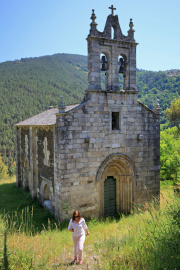
16.7 Iglesia nueva de la Cova
This route gives us a chance to enjoy the variety of landscapes found along the banks of the Miño River. They are defined by the various elements that characterise the places where people have settled, and by the various ways in which the land is being used.
The slopes that lead down towards the Miño River, and all of the smaller rivers and streams that flow into it, have different gradients, ranging from smooth rolling hills to very steep cliffs. Farmhouses, villages, and other settlements were generally positioned either higher or lower on these slopes, depending upon how steep they were.
Factors such as altitude, soil composition, availability of water, and orientation are elements that have determined which crops will be grown in each location. The wettest areas tend to be used for livestock grazing, while the driest are most suitable for cultivating grains. Areas that are rockier and oriented towards the south or west are good locations for vineyards, as they will receive the most sunlight. Vegetable gardens and fruit trees are primarily grown for self‑consumption (although surplus amounts were sold as well), and along with the chestnut forests, they tend to be located close to the houses.
It is worth remembering that many of these chestnut forests were planted centuries ago, then carefully maintained over the years to allow the chestnuts to be collected. These were a basic food source up until the time when potatoes arrived in the region.
And finally, there is one other key element that has been an essential part of human settlement in these landscapes, which is the local stone. Whether granite or slate, these stones have been used to build houses, terraces, walls, roads, boundaries, wells, and even refrigerators and beehives.
CHURCH OF SAN XOÁN DA COVA (12th century)
When the dam was being built, this church was relocated in 1953 and 1954 to prevent it from being submerged. This caused some minor modifications, such as loss of plaster coatings on the walls, elimination of the altarpiece, and construction of a new sacristy. A side door, which previously led to a small chapel that was not relocated, was sealed off. To one side of this, there is a tomb monument that features a recumbent Mother Superior statue, which is the church’s most notable element along with its main portal, which has an inscription on its tympanum honouring an important donor.
From here, looking towards the north, the Church of Santo Estevo de Atán (13th century) can be seen on the opposite shore. This church is notable for the structure of the building, for its mixture of various styles and eras, and for the paintings that decorate its interior.
 Directions
Directions 
